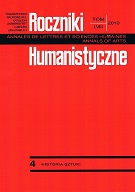"Nie odwracaj się". Esej o geście mitologicznym
"Don't Turn Back". An Essay on a Mythological Gesture
Author(s): Marta ZbańskaSubject(s): Cultural history
Published by: Towarzystwo Naukowe KUL & Katolicki Uniwersytet Lubelski Jana Pawła II
Keywords: myth; gesture; symbol; archetype; turning back; looking back; Orpheus; The Lady of Shallott; Lot's wife; mit; gest; symbol; archetyp; odwrócić się; spojrzeć za siebie; Orfeusz; Lady z Shalott; żona Lota
Summary/Abstract: Throughout history, cultures of diverse peoples often develop similar, virtually identical myths and legends. Although they are created independently in disparate communities, in different times and places, they reveal unbelievable similarities and analogies. This holds good for both fully-fledged stories and for individual elements of the plot, which become universallike symbols in human imagination over generations. This state of affairs testifies to the universal nature of “symbolic thinking,” and to the existence of common archetypical roots of all cultures, storing images of people, things and events that are symbolic in nature. Gestures are one of the archetypal elements. In the analysed case, gestures are understood as signs of natural expression, dictated by a more or less conscious impulse. These signs are manifestations of somatic and spiritual transforming experiences that a person goes through. They are also a means of communication between the person and the reality s/he experiences. In this sense, they give insight into this person’s reality. One of the most intriguing gestures is that of turning back, looking back on one’s past. It is known first of all from the Orphean myth and the biblical story about Lot’s wife. Nevertheless, it is also to be found in other stories all over the world. When he was about to leave the underworld – where he attempted to retrieve his wife Eurydice – Orpheus turned back despite the evident ban on doing so. Orpheus’ turning back doomed Eurydice to eternal imprisonment captivity in the world of the dead. Her despaired husband went back alone to the realm of the living. In a similar story, Coyote – a protagonist of a myth popular in a North American Indian tribe – followed his deceased wife to the world of the shadows. He failed to take his beloved back as he succumbed to the temptation of running to her and trying to touch her. Izanagi, a god in the Japanese mythology, ignored the warnings and when he went to the underworld, he took a torch and looked into the face of his deceased sister-wife Izanami. Brothers of a Hawaiian hero Maui also experienced the grave consequences of turning back, when they lost a chance of consolidating all the Hawai islands into an archipelago. A warning against turning back is also included in the Chinese Book of Changes (I Ching). A commentary to its last hexagram warns men against stopping on their way, encourages them to move forward and resist the temptation to stop and look back on the danger they have survived. The Bible also repeats a similar word of warning. The best known instance is the gesture of Lot’s wife, who turned back on her escape from Sodom. She was changed into a salt pillar. Also, the words of Jesus, who warns people against looking back when they start plough work. The last example comes from Tennyson’s story of Lady of Shalott, who turned back from the magical mirror.
Journal: Roczniki Humanistyczne
- Issue Year: 58/2010
- Issue No: 04
- Page Range: 311-329
- Page Count: 19
- Language: Polish

